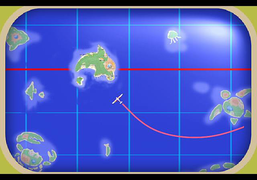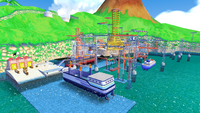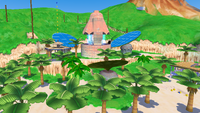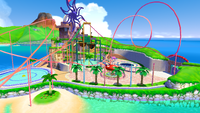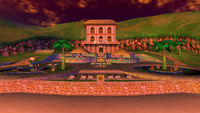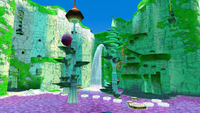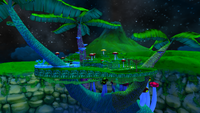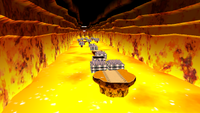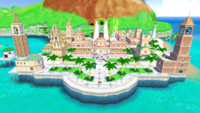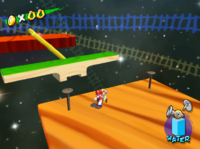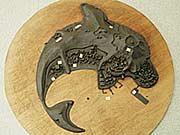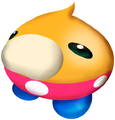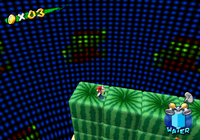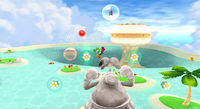Super Mario Sunshine
- This article is about the Nintendo GameCube game. For the WarioWare: Smooth Moves microgame based on this game, see Super Mario Sunshine (microgame).
- "Mario Sunshine" redirects here. For the team in Mario Superstar Baseball originally named "Mario Sunshines", see Mario Fireballs. For Mario's costume in Mario Kart Tour named "Mario (Sunshine)", see History of Mario § Mario Kart Tour.
| Super Mario Sunshine | |||||||||||||||||||
|---|---|---|---|---|---|---|---|---|---|---|---|---|---|---|---|---|---|---|---|
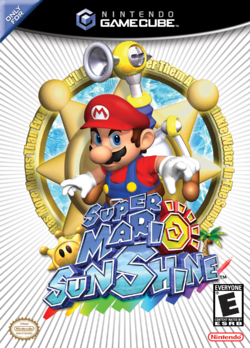 For alternate box art, see the game's gallery. | |||||||||||||||||||
| Developer | Nintendo EAD | ||||||||||||||||||
| Publisher | Nintendo | ||||||||||||||||||
| Platform(s) | Nintendo GameCube | ||||||||||||||||||
| Release date | Original release Player's Choice | ||||||||||||||||||
| Language(s) | English French (France) German Spanish (Spain) Italian Japanese | ||||||||||||||||||
| Genre | Platformer, action-adventure | ||||||||||||||||||
| Rating(s) |
| ||||||||||||||||||
| Mode(s) | Single player | ||||||||||||||||||
| Format | Nintendo GameCube:
| ||||||||||||||||||
| Input | Nintendo GameCube:
| ||||||||||||||||||
| Serial code(s) | |||||||||||||||||||
Super Mario Sunshine is a 3D action-adventure platform game for the Nintendo GameCube. It is the ninth entry in the Super Mario series[6][7] and the second 3D platformer, following Super Mario 64 (1996). The game's principal mechanic centers around FLUDD, a rechargeable water-based tool that can be used to spray enemies and goop, hover or launch through the air, and dash to high speeds. Super Mario Sunshine introduced many recurring characters and bosses to the Super Mario franchise, including the aforementioned FLUDD, Toadsworth, Bowser Jr., Petey Piranha, Gooper Blooper, Piantas, Nokis, and Shadow Mario, Bowser Jr.'s alter ego. It is the second game in the Super Mario franchise to feature extensive voice acting, the first being Hotel Mario, making it the first and thus far the only 3D Super Mario game with said extensive voice acting. It also features an Italian aesthetic, with many of the locations in the game (including Isle Delfino itself, the game's overarching setting) having Italian names and sometimes referencing Italian culture.
A port of Super Mario Sunshine is bundled in with Super Mario 3D All-Stars for the Nintendo Switch, featuring the original game with upscaled graphics, released on September 18, 2020. This is the only game in the overall main Super Mario series that has never been available as a standalone digital download.
Story
From the instruction booklet
Close your eyes and imagine...soothing sunshine accompanied by the sound of waves gently breaking on the shore. High above, seagulls turn lazy circles in a clear blue sky. This is Isle Delfino. Far from the hustle and bustle of the Mushroom Kingdom, this island resort glitters like a gem in the waters of a southern sea.
Mario, Peach, and an entourage of Toads have come to Isle Delfino to relax and unwind. At least, that's their plan... but when they arrive, they find things have gone horribly wrong... According to the island inhabitants, the person responsible for the mess has a round nose, a thick moustache, and a cap... What? But... that sounds like Mario!? The islanders are saying that Mario's mess has polluted the island and caused their energy source, the Shine Sprites, to vanish. Now the falsely accused Mario has promised to clean up the island, but... how? Never fear! FLUDD, the latest invention from Gadd Science, Inc., can help Mario tidy up the island, take on baddies, and lend a nozzle in all kinds of sticky situations.
Can Mario clean the island, capture the villain, and clear his good name? It's time for another Mario adventure to get started!
The game starts off in the Toad Express, where Mario, Princess Peach, a few Toads, and Toadsworth are flying out to Isle Delfino for a vacation. While watching a video advertisement showing its numerous attractions, Peach notices a Mario-shaped shadow figure jumping around in the background. Mario and Toadsworth do not notice this, as they dream about the food and having a good time.
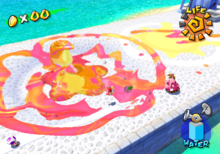
They make a rough landing on Delfino Airstrip, as a large amount of strange, moving goop in the shape of Mario's head is blocking the runway and has formed a pit. Mario goes on a brief search for something to assist him and soon finds a unique water pump invented by Professor E. Gadd named FLUDD, the Flash Liquidizer Ultra Dousing Device. The machine scans Mario and identifies him as its customer. After user instruction, Mario uses FLUDD to clean the goop and defeat a Proto Piranha after which the runway returns to its normal condition, and a Shine Sprite appears, which Mario collects.
After collecting the Shine Sprite, however, a pair of Pianta Police officers arrest Mario. In court, the prosecution reveals that the island is covered with similar goop, and the graffiti has forced all the Shine Sprites to flee. Eyewitness accounts indicate that Mario is the guilty party, and despite Princess Peach's attempted objection, Mario is found guilty and is ordered not to leave until the entire island is cleaned.
After defeating another Proto Piranha, the Grand Pianta Statue comes out of the ground with the mysterious character resembling Mario on top. This Shadow Mario attempts to kidnap Princess Peach, but Mario foils his plan and Shadow Mario escapes into the Rainbow M he paints on the base of the statue. This allows Mario to access Bianco Hills and recover more Shine Sprites. Later, similar incidents of various landmarks disappearing in goop happen around Delfino Plaza, and cleaning the goop reveals that these places also have portals to different areas of Isle Delfino.
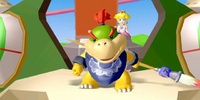
Once Mario recovers ten Shine Sprites, Shadow Mario kidnaps Princess Peach again and flees to Pinna Park. Mario chases Shadow Mario there and takes down his weapon, Mecha-Bowser. Shadow Mario comes out of Mecha-Bowser's head and reveals himself to be Bowser Jr., Bowser's son. He says that Bowser told him Peach is his mother who got kidnapped by a bad guy named Mario. He also reveals the graffiti to be the work of his magic brush, which he claims was given to him by "a strange old man in a white coat". Bowser Jr. then takes Peach to Corona Mountain by flying in Mecha-Bowser's head. Unable to rescue Princess Peach, Mario returns to cleaning up and recovering Shine Sprites. He also finds Yoshi and new nozzles for FLUDD to use, and unlocks more areas of Isle Delfino to explore. In Episode 7 of these areas, Mario must chase down Shadow Mario to obtain a Shine Sprite from him. When these episodes are cleared, Delfino Plaza is suddenly flooded after a surge of water came gushing out of the cave behind the Shine Gate. This flood also wound up destroying the barrier obstructing the cave entrance, allowing Mario access into Corona Mountain. Working his way to the top of the volcano, Mario finds Bowser and Bowser Jr. relaxing in a huge hot tub of sludge with Peach with them. Mario then battles Bowser and Bowser Jr. by using the Rocket Nozzle and then ground pounding from high up onto the five platforms protruding from the tub while avoiding Bowser and Bowser Jr.'s attacks. The force of the ground pound on the last platform flips the tub end-over-end and everyone plummets down out of Corona Mountain, while a large Shine Sprite hidden in the pool flies out.

Bowser, Bowser Jr., Mario, and Peach fall from the sky. Mario lands head-first onto an island just west of Delfino Plaza, while Peach floats down with her umbrella and lands softly on the same island that Mario landed on. However, their reunion is cut short when they see FLUDD malfunctioning, having been heavily damaged during the battle against Bowser. In its final moments, FLUDD asks Mario if it was "of assistance" before shutting down. While Mario hangs his head over his friend, Peach directs his attention to the plaza, where the Shine Sprite from the hot tub returns to the Shine Gate, and the residents of Isle Delfino celebrate as its light is fully restored. Far away from the island, Bowser and Bowser Jr. (who landed on a raft) watch the celebration from the raft. Bowser Jr. had figured out by then that Peach was not really his mother, but wants to fight Mario again. Bowser praises his son and says that they rest a while. Later on, as Mario and Peach enjoy a sunset at Sirena Beach, they notice the Toads carrying a fully repaired FLUDD, who promptly states, "The vacation starts now!" Pictures of their vacation are shown during the credits, depicting Mario and his friends enjoying the island and its wonders. After the credits, a picture of Il Piantissimo discovering the magic brush in the sands of Gelato Beach is shown, along with "The End" displayed in the lower right hand corner. However, defeating Bowser after collecting all 120 of the Shine Sprites replaces this picture with a group picture of friendly characters in the game posing in Casino Delfino, with text reading "Have a relaxing vacation!" on the bottom.
Gameplay

Super Mario Sunshine is a 3D platformer where players control Mario in an open environment in a similar manner to its predecessor, Super Mario 64. As with all 3D platformers, players can adjust the camera to their liking. Due to closer objects obstructing features on the level, when certain characters and items are obscured by minor objects such as walls or trees, their silhouettes are marked by a big '?'. This does not apply to Mario and his FLUDD, to differentiate him from the features.
Super Mario Sunshine is the first game where Mario extensively uses an accessory to complete his mission. FLUDD (Flash Liquidizer Ultra Dousing Device) features spray and hovering capabilities when it is first acquired; other nozzles can be unlocked to extend FLUDD's functionality, such as the "Rocket Nozzle" which propels Mario high into the air, and the "Turbo Nozzle" that lets Mario sprint on land and water, as well as break down wooden doors.
The game contains a number of independent levels which can be reached from Delfino Plaza. Gameplay is based around collecting Shine Sprites by completing various tasks in the levels and over world, very similar to Super Mario 64, but with Shine Sprites instead of Power Stars. However, unlike in Super Mario 64 where the player could usually get most Power Stars no matter which mission was chosen, this game usually lets Mario obtain only the Shine Sprite pertaining to the episode that the player selects from the screen prior to the level.
There are 120 Shine Sprites and 240 blue coins in the game. A Raccoon will exchange a Shine Sprite for ten blue coins in the boathouse at Delfino Plaza. There are two Shine Sprites at the Airstrip, seventeen in the plaza (including one for collecting 100 coins and one in Corona Mountain), and 11 in each of the seven other areas (eight from main episodes, two hidden, and one for getting 100 coins). There are 30 blue coins in each of the seven areas, making 210, there are 19 in the plaza, one in the Airstrip, and ten in Corona Mountain, making 240 altogether.
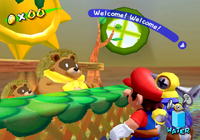
At first, each of the seven areas features one task which may be completed to acquire a Shine Sprite. The player is then returned to Delfino Plaza and a new task is unlocked in the area they just played. Each area consists of up to eight of these tasks, as well as two hidden tasks, which may be played again at will once they are completed. Once the player has collected enough Shines in total, a new level is available at Delfino Plaza, either by the acquisition of a new ability or some plot-related event, such as Shadow Mario appearing in the Plaza.
Gameplay proceeds in this fashion until all of Shadow Mario's related missions are completed (the seventh mission of each level), which unlocks Corona Mountain, containing the final boss. As the total number of Shine Sprites available to obtain at any given point is greater than the number of Shine Sprites needed to unlock the next area, players may choose which tasks they want to attempt.
Mario can also ride Yoshis in this game, making Super Mario Sunshine the first 3-D Super Mario game to incorporate this functionality, being followed by Super Mario Galaxy 2. Yoshis can be used to eat enemies, as well as certain insects and Birds that can produce gold, blue, or red coins, and even Shine Sprites in a few cases. Yoshis can also eat fruit and squirt the juice of the color of that fruit, just like FLUDD sprays water. This juice can be used to dissolve certain kinds of pulsating goop acting as obstacles, as well as to briefly transform enemies into platforms for Mario to step on. The color of the Yoshi, as well as the effect of its juice, depends on the type of fruit last eaten. However, Mario cannot take Yoshi with him when he accesses a new area, meaning that Yoshi is only usable in certain areas and certain missions, and if Yoshi runs out of juice or touches deep water he will vanish, requiring Mario to find the egg and hatch it again.
Controls
With the exception of the iteration included in Super Mario 3D All-Stars for Nintendo Switch systems, the game can only be played with the Nintendo GameCube Controller. For the control scheme of the Super Mario 3D All-Stars iteration, click here.
| Action(s) | Input(s) | |||
|---|---|---|---|---|
| Mario controls | ||||
| Move | ||||
| Sidestep | ||||
| Jump, swim | ||||
| Double jump | ||||
| Triple jump | ||||
| Spin jump | Rotate | |||
| Side somersault | ◀ | |||
| Broad jump | ||||
| Wall kick | ||||
| Ground pound | ||||
| Talk, read, engage object, dive underwater | ||||
| Slide, throw item | ||||
| Hang from rope, let go of rope | ||||
| Climb onto rope | ||||
| Super whirl jump | ||||
| Climb | ||||
| Flip grate | ||||
| Use FLUDD, refill FLUDD | ||||
| Switch nozzle | ||||
| Direct spray (Squirt Nozzle only), hover (Hover Nozzle only) | Firmly press | |||
| Spray while moving (Squirt Nozzle only) | Lightly press | |||
| Sidle squirt (Squirt Nozzle only) | ||||
| Sprinkler squirt (Squirt Nozzle only) | Rotate | |||
| Back somersault (Squirt Nozzle only) | ||||
| Launch horizontally (Turbo Nozzle only), launch vertically (Rocket Nozzle only) | Hold | |||
| Move camera | ||||
| Enter over-the-shoulder view | ||||
| Enter first-person view | ||||
| Yoshi controls | ||||
| Move | ||||
| Jump | ||||
| Flutter jump | Hold | |||
| Ground pound | ||||
| Eat | ||||
| Spray juice | ||||
| Direct juice | Firmly press | |||
| Spray juice while moving | Lightly press | |||
| Dismount Yoshi | ||||
| Menu controls | ||||
| Navigate menu | ||||
| Confirm command | ||||
| Cancel command | ||||
| Access Guide Book | ||||
| Display pause menu | ||||
Locations
Setting
Super Mario Sunshine takes place on Isle Delfino, a tropical archipelago shaped like a dolphin. It is removed from the usual setting of the Mushroom Kingdom. This is similar to Super Mario World, another game set on a distinct, isolated landmass.[8] It is a bustling island that features shops, a fishing industry, a tourist community, and a theme park. The most numerous locals on the island are mountain people called Piantas and sea people called Nokis. During the opening cutscene it is shown that Isle Delfino is surrounded by other archipelagos shaped like animals. Examples include: a crab (southwest), a sea turtle (southeast), a jellyfish (northeast), and a mola (northwest). This cutscene implies Isle Delfino is located along the Earth's equator, but an official atlas released to promote Super Mario Odyssey – a subsequent title directly influenced by Sunshine and its predecessor[9] – places it in the southern hemisphere, northwest of the Mushroom Kingdom.
A core concept for Super Mario Sunshine was to create a game where Mario is equipped with a water pump, an idea conceived by producer Shigeru Miyamoto. The tropical island setting was decided on early in development because the staff thought it would compliment this concept.[10] Isle Delfino's dolphin shape was potentially influenced by the codename for the Nintendo GameCube – "Project Dolphin".[11][8][12] The overall look of the island is inspired by tropical environments, such as those of Hawaii or southeastern Asia.[10] The buildings, architecture, and location names derive from Italy and other coastal European nations. Amalfi has been cited as a particularly likely source of inspiration.[12][13][14] The layout of the towns on Isle Delfino are based on resort communities.[10] Courses are not interconnected and can only be accessed through Delfino Plaza, the game's hub world. However, despite being unreachable, courses can be previewed in all corners of the island. For example, Ricco Harbor is viewable from the starting position of Bianco Hills, and Pinna Park is also visible off near the horizon. This creates the impression of a fully realized, interconnected world. Individual courses feature various landmarks to reduce the likelihood of the player getting lost, a design choice derived from urban planning.[15] A fixed focal point viewable from all courses is Corona Mountain. It is an active volcano that is homologous to the eye of the dolphin. The volcano is the last course unlocked and is the setting of the final boss fight with Bowser. Having it as a central fixture in all courses serves as foreshadow for the climatic showdown. Isle Delfino was conceived by director Yoshiaki Koizumi, who wanted to craft a setting that was more believable and natural than the world present in Super Mario 64.[10] The design of the individual courses derive from the principles of hakoniwa, or "box gardens". The purpose behind hakoniwa is to create intricate, miniature landscapes in a closed space.[15][16]
Courses
There are at least nine dedicated levels in Super Mario Sunshine: eight courses that are gradually unlocked as the player collects Shine Sprites and one interconnecting hub world. Delfino Airstrip is the setting of the game's prologue and is available to visit via ferry after entering Corona Mountain. It has two dedicated episodes and is listed as its own course within the game, but it shares the 100 coin bonus Shine with Delfino Plaza. With the exceptions of Corona Mountain and Delfino Airstrip, each course grants the player access to at least one otherworldly subarea called a secret course (see below). If these areas were to also be considered levels, then there as many as twenty-seven levels in the game. The table below provides overviews for the ten courses listed in the game and their corresponding episodes. ![]() and
and ![]() denote the number of obtainable Shine Sprites and blue coins within each course, respectively. The descriptions come from the in-game Guide Book.
denote the number of obtainable Shine Sprites and blue coins within each course, respectively. The descriptions come from the in-game Guide Book.
Secret courses
Every area in the game has one or two secret levels. These are never part of the regular area and are usually inside an alcove (barred off after defeating the level). These secret levels start with a short cutscene of Mario falling through a white area and Shadow Mario stealing FLUDD, thus leaving Mario only to rely on his acrobatic skills. These levels can also be revisited, but FLUDD will be accessible to aid in movement. When revisiting, there is also a red button that, when ground-pounded, makes eight red coins appear throughout the level and sets off a timer. The red coins must be collected before the timer runs out or Mario loses a life and has to restart the level. Collecting them results in one of the two hidden Shine Sprites in that area appearing.
These levels feature a cover of "Ground Theme" from Super Mario Bros. in a rhythmic, upbeat, a cappella style accompanied by snapping fingers. Secret levels are staged in an apparently infinite void in which Mario may fall and lose a life. Various platforms and obstacles are found in the level, including the following:
- Red and blue platforms that flip constantly. Mario alternates between red and blue platforms because all the red platforms flip at the same time, followed by all the blue ones.
- Long, square-faced wooden blocks with colored knobs that rotate, so Mario must run along them at an angle while avoiding the pegs or risk falling off.
- Cubes made of glass with white edges that have colored corners that frequently sit at the edge of a platform (or shortly off it). These will carry Mario on the top and move to otherwise-unreachable platforms as they rotate and turn. Mario must walk to the flat edge to keep from falling.
- Sand blocks that crumble as Mario steps on them (but regenerate shortly). These are often arranged into a long path or a sand castle or pyramid that has to be navigated through that is continually breaking apart.
- Blocks that disappear and reappear at regular intervals, regardless if Mario steps on one of them.
- Moving a Yoshi Egg patterned blocks in different colors that move in a set path and must be jumped across in order. They move through two archways, one of which stops Mario if he tries to pass through it.
- Orange blocks with no special characteristic other than moving in every direction. They are arranged in large groups.
- Some platforms have nails sticking out of them. If Mario ground pounds on them three times they will be completely in the ground and he can get a few coins, a 1-Up Mushroom, or nothing. They are usually on large, stationary platforms.
When losing a life on the secret levels, Mario will restart at the starting point of the level as opposed to returning to Delfino Plaza. If the player runs out of lives, however, he returns to the plaza.
There is also a second, rare type of secret levels, included below. In these secret levels, Mario always has access to FLUDD. These levels always take place in the sky and have a different background music. One appears in Episode 4 of Gelato Beach, and one in Episode 3 of Noki Bay. Secret levels of this type are also available in Delfino Plaza.
Characters
Mario
| Name | Description |
|---|---|
 Mario |
The hero of the Mushroom Kingdom and the game's protagonist. He arrives at Isle Delfino with the intention of going on vacation with Princess Peach. However, a shadowy doppelgänger has been polluting the island and stealing its Shine Sprites. This paints Mario as a trouble-maker and results in his arrest shortly after arriving. Throughout the course of the game, Mario strives to clean the island, restore the Shine Sprites, and clear his name. Mario wears a short-sleeved red shirt in this game instead of his usual long-sleeved one. |
Yoshi
| Name | Description | Locations |
|---|---|---|
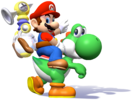 Yoshi |
A dinosaur-like creature that can be ridden by Mario. He can be used in certain areas after completing "Event 6: Shadow Mario and the Yoshi Egg". Yoshi can perform some of the same actions as Mario, as well as Flutter Jump and eat enemies with his long tongue. Instead of water, he can spray fruit juice. Different juice has different properties: the type of juice sprayed depends on the last fruit eaten by Yoshi and is also indicated by the color of his skin. Yoshis once lived on Isle Delfino and their likeness is incorporated into rides at Pinna Park. However, they disappeared after Snooza Koopas started to populate the island. Like the enemies in the game, this Yoshi was created by Bowser Jr. and is made out of goop. He will immediately vanish when he enters deep water as a consequence.[17] | Delfino Plaza, Bianco Hills, Ricco Harbor, Gelato Beach, Pinna Park, Sirena Beach, Pianta Village |
Non-playable characters
| Name | Description | Locations |
|---|---|---|
 FLUDD |
Mario's robotic companion - the Flash Liquidizer Ultra Dousing Device. Many of Mario's new actions come from utilizing FLUDD, as it enables him to hover and spray water. Progressing through the game unlocks new equippable nozzles that give FLUDD different abilities. During "The Goopy Inferno" episode and most secret courses, FLUDD is temporarily stolen by Shadow Mario, forcing Mario to navigate the course by himself. Both Shadow Mario's magic brush and FLUDD were built by a mad scientist at Gadd Science, Incorporated. | All courses |
Princess Peach |
The ruler of the Mushroom Kingdom. While on route to Isle Delfino, she is the only one who notices Shadow Mario in the tourist tape that plays on the plane. She attempts to convey what she sees to Mario and Toadsworth, but they are too busy daydreaming about their vacation. After Mario's arrest, her suspicions are verified when Shadow Mario appears and attempts to kidnap her during the "Shadow Mario Chase" event, only to be rescued by Mario. She remains present in Delfino Plaza and will give Mario words of encouragement until the "Princess in Trouble" event, during which Shadow Mario returns and successfully abducts her. She is held prisoner on Corona Mountain for the remainder of the game. She represents Mario during his trial at the beginning of the game. | Delfino Airstrip, Delfino Plaza, Corona Mountain |
 Toadsworth |
An elderly Toad who serves as Peach's steward. He travels with the princess and Mario to Isle Delfino, but the situation on the island leaves him flustered and worried for Peach's safety. After her kidnapping, he is left in a state of perpetual panic for the rest of the game. | Delfino Airstrip, Delfino Plaza |
 Toads |
A quintet of young Toad attendants. They travel to Isle Delfino as the princess's aides. They are distributed across Delfino Plaza and share pieces of history about the island when prompted until Peach is kidnapped by Shadow Mario. Like Toadsworth, they remain in a state of panic for the remainder of the game. | Delfino Airstrip, Delfino Plaza |
 Piantas |
Cheerful mountain people that wear grass skirts and grow palms from their heads. They are the most numerous inhabitants of Isle Delfino and have built it up as a tourist community. Because of Shadow Mario's mischief, most Piantas are initially rude and dismissive of Mario, but they will gradually warm up to him as he restores the island. Piantas calling themselves "chucksters" pride themselves in their ability to throw things great distances and will toss Mario if prompted. The ancestral home of the Piantas is Pianta Village. | Delfino Airstrip, Delfino Plaza, Bianco Hills, Ricco Harbor, Gelato Beach, Pinna Park, Sirena Beach, Pianta Village |
 Hotel manager |
The manager of Hotel Delfino. Phantamanta and Boos disturb the hotel grounds and threaten his business. He awards Mario with Shine Sprites for helping restore his hotel. | Sirena Beach |
 Mayor |
The mayor of Pianta Village and the host of the Fluff Festival. He becomes reliant on Mario when the people of Pianta Village are endangered by Shadow Mario. He awards Mario with Shine Sprites for restoring the village and saving his people. During the "Fluff Festival Coin Hunt" episode, a local shares that the mayor secretly stashes money "in" the sun. Spraying water towards the sun awards him with a Shine Sprite. | Pianta Village |
 Raccoons |
Shopkeepers that look like tanuki. One lives in the boathouse on Delfino Plaza with his son, where Mario can trade him ten blue coins for one Shine Sprite. Another individual runs a boat rental in Noki Bay. | Delfino Plaza, Noki Bay |
  Nokis |
Timid sea people that look like marine snails. They will retract into their shells when threatened. Nokis can thrive in saltwater but are highly sensitive to pollution. The dirty sea of their ancestral home, Noki Bay, forced most individuals to flee. They will return in large numbers once Mario fully restores the area. | Gelato Beach, Pinna Park, Sirena Beach, Noki Bay |
 Park Director |
The theme park director for Pinna Park. During the "Mecha-Bowser Appears!" episode, he mistakenly believes Mario is his employee and is putting on a grand stage show. He permits the use of his roller coaster to make the show more exciting. The director never becomes the wiser. | Pinna Park |
 Noki elder |
A scatterbrained Noki who works with Mario to restore Noki Bay. He enables Mario to dive deep underwater by giving him a helmet. | Noki Bay |
 Blooper Racers |
Bloopers owned by Big Daddy that Mario can ride during episodes involving Blooper Surfing. Each of the three Blooper Racers have different stats: a green one is slow with good handling; a yellow one with average speed and handling; and a pink one that is fast with poor handling. Colliding with most obstacles will cause Mario to immediately fall off and lose a life. | Ricco Harbor |
 Sand Bird |
A giant, legendary creature made out of sand blocks. Its egg incubates inside the Shine Tower of Gelato Beach, where its survival is initially threatened by a giant Wiggler during the "Mirror Madness! Tilt, Slam, Bam!" episode. It hatches sometime before "The Sand Bird is Born", during which it can be found soaring high in the sky. | Gelato Beach |
 Il Piantissimo |
An arrogant man dressed as a Pianta. He will challenge Mario to a footrace when prompted. Beating him awards the player with a Shine Sprite. The Piantas of Pianta Village describe Il Piantissimo as "creepy". | Gelato Beach, Noki Bay, Pianta Village |
 Sunflowers |
Giant flowers that grow on the beach outside Pinna Park. They have gentle and sunny dispositions. Spraying a Sunflower Kid with water causes it to giggle and give Mario a coin. Snooza Koopas cause the Sunflower Kids to wilt by eating their roots during "The Wilted Sunflowers" episode. The mother flower, the Great Sunflower, will give Mario a Shine Sprite for defeating them. | Pinna Park |
Enemies and obstacles
Enemies
About forty enemies occur in Super Mario Sunshine, many of which are restricted to one course. While a few enemies can be stomped or ground-pounded, most of them are defeated when sprayed by FLUDD and this is reflected in their designs. Some stompable enemies drop rarer items if sprayed instead.
This game has highly distinctive enemy designs and does not include many traditional enemies from previous titles, such as Goombas or Koopa Troopas. The ones included that did appear in prior games have very distinctive designs different from their previous and subsequent appearances in the series. The majority of the new enemies introduced are not integrated into subsequent Super Mario games. According to the Super Mario Bros. Encyclopedia, the enemies in Super Mario Sunshine were created by Bowser Jr. using the magic brush and are made out of goop. This is supposedly why they are vulnerable to water and why they look so different from other enemies in the series.[17] However, Bloopads, Cheep-Cheeps, and Pondskaters do occur in water, and Poinks can be filled with it.
Sorting the "course" columns organizes them by occurrence in-game, not alphabetically.
| Name | Description | Courses | Spoils | New | |
|---|---|---|---|---|---|
| First | Last | ||||
 Gooble |
Gelatinous enemies that materialize directly from piles of goop. They move very slowly but fling themselves at Mario when he is near. If they miss, they splatter into goop. They can climb up walls and leave trails of goop behind them. One falls apart when sprayed. | Delfino Plaza | Pianta Village | ||
 Pokey Pod |
Pokey heads. They hide underground with only their flowers exposed. They burst to the surface when approached and bounce towards Mario. The flower is the weak point and can be stomped. | Bianco Hills | Red Coin Field | ||
 Seedy Pod |
Singing Pokey Pods. Approaching them causes them to bury their bodies underground and release a flurry of projectile seeds. Spraying them with water from a distance stuns them temporarily and leaves them vulnerable to attack. | Bianco Hills | Red Coin Field | ||
Pokey |
Segmented cactus enemies. Their body is covered with spines and will damage Mario if jumped on, but their head is vulnerable. They hide with only their flower exposed but will burst from the ground if Mario is in close proximity. Unlike Pokey Pods, Pokeys are stationary: they will instead try to strike Mario with their head by falling forward. Doing so temporarily leaves them vulnerable and allows Mario to jump directly on their head. | Bianco Hills | Pianta Village | — | |
 Strollin' Stu |
Stout, waddling creatures that make squeaky noises and come in a variety of sizes. They will run towards Mario when they make visual contact. Small varieties appear in a secret course that emerge from little holes in the wall. A group in Pinna Park is made of several small ones stacked on a large one. | Bianco Hills | Delfino Airstrip | ||
 Smolderin' Stu |
Fiery Strollin' Stus. Making direct contact will burn Mario. Spraying them with water extinguishes the flames and allows them to safely be defeated. | Pinna Park | Sirena Beach | ||
 Swipin' Stu |
Large, winged Stus. They will swoop down towards Mario when in close proximity and try to steal his cap. They can be forced to the ground by spraying them with water. | Pinna Park | |||
 Winged Strollin' Stu |
Winged Stus that either pursue Mario from above or fly horizontally across a set path. | Pinna Park | Delfino Airstrip | None | |
 Piranha Plant |
Carnivorous plants born from goop. They shoot globs of goop at Mario. Their bellies expand with water if sprayed and will eventually explode. | Bianco Hills | — | ||
 Piranhabon |
Giant Piranha Plant heads that roll down slopes like boulders. They are covered in goop and leave trails of it behind them as they roll. | Bianco Hills | None | ||
 Glorpedo |
Bouncy globs of goop that are shot by Petey Piranha and from Monty Mole's cannon in Noki Bay. The former simply explode into goop on impact, but the latter leave trails of goop behind them as they bounce and roll down the slopes of the cliffs. Spraying them with water causes them to expand and eventually burst. Jumping on them causes them to collapse as a puddle of goop. | Bianco Hills | Noki Bay | ||
 Bee |
Aggressive bees that will attack Mario if he is near their hive. Spraying the hive causes it to break and unleashes a swarm of many bees. They are the smallest enemies in the game and cannot directly be defeated by Mario. Spraying them with Yoshi's juice does not transform them into platforms, but he can eat them. Eating all of the bees in a swarm awards the player with an infrequent collectible. | Bianco Hills | Pianta Village | — | |
 Plurp |
Chicken enemies that drop goop as they fly through the sky. They can be brought low to the ground by shooting them with water and jumped on. | Bianco Hills | Pianta Village | ||
 Wind Spirit |
Swirls of wind that home-in on Mario. Though difficult to see due to their translucent bodies, Wind Spirits are always accompanied by the sound of wind gusts before striking. | Bianco Hills | Pianta Village | ||
 Pondskater |
Water strider enemies. They skim on the surface on the water and make short bursts of movement by contracting their legs. They temporarily freeze in place if sprayed with water. Jumping on their bodies makes Mario bounce to an extreme height. | Bianco Hills | None | — | |
 Poink |
Floating, balloon-like pig creatures. They will suckle on FLUDD's nozzle when Mario is in close proximity. They can be filled with water and launched from FLUDD like rockets. Poinks do not inflict damage on Mario. | Bianco Hills | Sirena Beach | None | |
 Wire Trap (Red) |
Electrically-charged obstacles that look like spiral snail shells. They move slowly along wire ropes. They will shock Mario on contact, but they do not make him lose his grip or balance if he is on the rope. The small red ones can either travel from one end of a wire before disappearing and respawning in their original location, or follow Mario along the wire. | Bianco Hills | Noki Bay | — | |
 Wire Trap (Blue) |
The larger blue Wire Traps, which bounce from one end of the wire to the other. | Noki Bay | |||
 Blooper |
White squids that shoot globs of black goop at Mario. Spraying them with water leaves them dazed. Bloopers are only found on dry land. They will disappear in a cloud of smoke if they make contact with bodies of water. | Ricco Harbor | Noki Bay | — | |
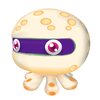 Bloopad |
Small Bloopers that leap from water. Spraying them with water causes their mantles to temporarily flatten and float on the surface of water, allowing them to be used as platforms. | Ricco Harbor | None | ||
 Klamber |
Spider-like creatures that cling to walls, ceilings, and chain-links. Spraying them with water can temporarily demobilize them. | Ricco Harbor | Pianta Village | ||
 Cheep-Cheep |
Pudgy red fish that leap from water. They do not actively pursue Mario. When marooned on land, they will helplessly flail about. This only has the potential to occur during the boss fight with King Boo. | Ricco Harbor | Sirena Beach | None | — |
 Cheep-Cheep (Pink) |
These Cheep-Cheeps pursue Mario underwater. One latches onto him pulls him deeper. | Gelato Beach | Delfino Airstrip | None | |
 Lava Cheep Cheep |
Cheep-Cheeps that swim in the magma of Corona Mountain. Spraying them with water incapacitates them temporarily. | Corona Mountain | None | ||
 Cataquack (Blue) |
Duck-like creatures that toss Mario high into the air. This does not deplete his life meter unless he falls on the same patch of ground from which he was launched. They will immediately charge towards Mario after making visual contact. They otherwise will idly patrol the beach or sleep on the ground. Spraying them with water will temporarily leave them dazed, allowing Mario to jump on them, which will cause them to sink into the ground. Spraying them while they are over sand will make them sink without having to jump on them. Mario himself cannot defeat Cataquacks, but they can be eaten by Yoshi or splattered after being launched by a Dune Bud. | Gelato Beach | Sirena Beach | ||
 Cataquack (Red) |
Red Cataquacks that always damage Mario when they toss him into the air. Their behavior is otherwise shared with the blue Cataquacks. | Gelato Beach | |||
 Bullet Bill |
Missiles with smiley sharkmouths. They first appear loosely following the roller coaster tracks during the Mecha Bowser fight at Pinna Park. The ones fired from Monty Mole's cannon on Pinna Beach simply fly in a downwards arc, exploding when they hit the ground. The ones fired from Bowser Jr.'s boat over Corona Mountain have blinking red nosecones like the purple variants and will lock onto Mario. | Pinna Park | Corona Mountain | — | |
 Bullet Bill (Gold) |
Bullet Bills launched from Monty Mole's cannon on Pinna Beach. Spraying them with water causes them to explode into eight coins, which will vanish shortly if they are not collected in time. | Pinna Park | |||
 Bullet Bill (Purple) |
Bullet Bills that loosely home-in on Mario once they approach the ground, but only horizontally. They are fired from Monty Mole's cannon on Pinna Beach. They can quickly be distinguished from normal Bullet Bills by their blinking red nosecones. | Pinna Park | |||
 Bullet Bill (Blue) |
Blue Bullet Bills launched from Bowser Jr.'s ship during the final fight with Bowser. They will home-in on Mario similarly to purple ones, but are also able to adjust their vertical position. They can be jumped on and sprayed with water. | Corona Mountain | |||
 Bob-omb |
Walking bombs that look like wind-up toys. They are thrown at Mario by Monty Mole when he gets close to his cannon. They heat up once the key on their head begins to turn and will walk towards Mario. They detonate after three seconds. Spraying them with water will cause them to retract their legs and freeze, allowing them to be picked up. They can still detonate in this form. | Pinna Park | Noki Bay | — | |
 Snooza Koopa |
Finned Koopas that feed on the sunflower people. They bury their bodies under the sand. Spraying them with water forces them to the surface. A Snooza Koopa will try to crush Mario by throwing itself into the air and slamming down, carapace-first. Performing a Ground Pound on its plastron defeats it. Their carapaces resemble Yoshi Eggs. The Great Sunflower initially mistakes them for actual Yoshis. | Pinna Park | |||
 Electro-Koopa (Blue) |
A variety of Koopa. They sport electrically-charged shells that will shock Mario on contact. A Blue Electro-Koopa will remove its shell and toss it towards Mario as a projectile weapon. It is in this instance that it can be safely jumped on and defeated. | Pinna Park | Sirena Beach | ||
 Electro-Koopa (Red) |
A large variety of Electro-Koopa that clings to walls, ceilings, and chain-links. Their carapace will shock Mario on contact, but their plastron is vulnerable to damage. Mario can strike them when on the opposite side of a steel grate. If he makes direct contact with one on the same side of the grate, he will be shocked, immediately lose his grip, and fall. | Pinna Park | Pianta Village | ||
 Electro-Koopa King |
A giant Electro-Koopa sleeping on a metal grate behind Pinna Park's Ferris wheel. Touching its shell directly shocks Mario. It can only be defeated by flipping the grate it sleeps on. | Pinna Park | |||
 Boo |
Ghost enemies. They can turn invisible and will disguise themselves as coins. This is the only incarnation of this enemy in the Super Mario series that will not cower when directly faced by the player, can be jumped on to defeat, and can be eaten by Yoshi. | Sirena Beach | — | ||
 Block Boo |
Pink Boos that turn into stationary platforms when sprayed with water. They float in a set path and do not actively pursue Mario. They cannot turn invisible and cannot be defeated. | Sirena Beach | None | — | |
 Sleepy Boo |
Large Boos that sleep in the attic of Hotel Delfino. Their bodies obstruct the halls. Yoshi can eat Sleepy Boos and this is the only way to remove them. | Sirena Beach | |||
 Chain Chomplet |
Young Chain Chomps owned by an orange Pianta. They suffer from a fever that turns their bodies orange and makes them too hot to touch. As they move, they leave trails of burning goop behind them that will burn Mario. He can cool them down with water and grab onto their chains. Pulling back and releasing them will slingshot the Chomplets. They permanently become tame if launched into a body of water. | Pianta Village | |||
 Chain Chomp |
A giant, toothy monster that looks like a ball-and-chain. It suffers from an intense fever that makes it too hot to touch, but spraying it with water cools its body and calms it down. Its chain can be grabbed and dragged by Mario after it is cooled. The Chain Chomp will become completely soothed if dragged into the Pianta Hot Spring and will turn gold. It is owned by an orange Pianta and is potentially the parent of her Chain Chomplets. | Pianta Village | — | ||
Obstacles
| Name | Description | Courses | Spoils | |
|---|---|---|---|---|
| First | Last | |||
 Brambles |
Thick vines covered in thorns. Making contact with them damages Mario. | Bianco Hills | ||
 Burning goop |
Fiery, orange goop that burns Mario on contact. It otherwise functions like regular goop. Feverish Chain Chomplets will leave trails of burning goop in their wake. | Pianta Village | ||
 Cheep Cheep / Puncher |
Traps hidden within the alcoves of Noki Bay that launch Mario when triggered. Cheep Cheeps are green figures similar to the bird apparatus of a cuckoo clock, and Punchers are red boxing gloves. Punchers launch Mario much farther than Cheep Cheeps. | Noki Bay | ||
 Electric goop |
Electrically-charged goop that is spread by Phantamanta. It functions like regular goop, but it will electrocute Mario if he makes direct contact with it. | Sirena Beach | ||
 Goop |
A pollutant spread all over Isle Delfino by Shadow Mario. Mario's traction is reduced when he walks through goop and it makes him slip and slide down slopes if it is on an angled surface. Staying in goop for too long damages him. It can trap people and parts of the terrain. Spraying goop with water causes it to dissipate, free people, and restore the natural environment of a given area. Goop can be a variety of colors and is shot as a projectile by numerous enemies. Some enemies, such as Goobles and Piranha Plants, directly spawn from goop. It apparently tastes like candy. | Delfino Airstrip | Sirena Beach | |
 Hot water |
Gelatinous goop that burns Mario on contact. It cannot be sprayed away. | Corona Mountain | ||
 Magma |
Molten rock within the lava caves of Corona Mountain. Unlike burning goop, making direct contact with magma will cause Mario to immediately lose a life. | Corona Mountain | ||
 Oil |
Black goop that sits on the surface of bodies of water. It cannot be sprayed away with water and damages Mario on impact. Blooper Racers can safely swim through it. | Ricco Harbor | ||
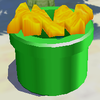 Orange Juice Generator |
Concentrations of goop that obstruct portals and items of interest. It normally lays still but will involuntarily begin to fluctuate when in close proximity to Mario. It will damage him on contact and cannot be sprayed away by water. It can only be sprayed away by Yoshi's juice. | Delfino Plaza | Pianta Village | None |
 Poison |
Poison mixed with water. Mario will lose a life if he makes direct contact with it. It causes the rideable lily pads that sit on the water to decay, erode, and ultimately fall apart if Mario stands on them for too long. | Delfino Plaza | Bianco Hills | |
 Slimy water |
Sea water mixed with goop. It cannot be sprayed away and swimming in it causes Mario's health to gradually fall. | Noki Bay | ||
 Spikes |
Platforms erected in the caves of Corona Mountain. The spikes protract and retract from the top of the trap in set intervals that can be timed. The spikes cause significant damage to Mario if he makes direct contact. | Corona Mountain | ||
Bosses
Bosses are listed in the order that they are first encountered.
| Name | Description | Episodes / Events | Spoils |
|---|---|---|---|
| Mid-Bosses | |||
 Proto Piranha (orange) |
Protoplasmic Piranha Plants that erupt from piles of goop. Shooting water in its open mouth weakens it. | Delfino Airstrip Dilemma | |
 Proto Piranha (brown) |
Proto Piranhas that spawn more goop around them as well as Goobles. | Event 1, Road to the Big Windmill | |
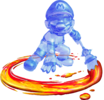 Shadow Mario |
The mysterious doppelgänger that frames Mario. He periodically appears in Delfino Plaza and must be chased down. He is defeated when sprayed with water, but it is complicated by his small size, speed, and nimble jumps. Defeating him triggers important story events or gives Mario access to new abilities. Defeating Shadow Mario in courses rewards Mario with a Shine Sprite. | Event 2, Event 6, Event 8, Event 9, Shadow Mario on the Loose, Shadow Mario Revisited, It's Shadow Mario! After Him!, Shadow Mario in the Park, Shadow Mario Checks In, Hold It, Shadow Mario!, Shadow Mario Runs Wild | |
 Proto Piranha (black) |
Proto Piranhas that spawn goop and Goobles. They are twice as durable as the orange and brown varieties. | Event 3, Event 4 | |
 Plungelo |
Cataquack-like creatures that stick to platforms. Shooting one with water puts it off balance and leaves it vulnerable to attacks. | Mirror Madness! Tilt, Slam, Bam! | |
 Monty Mole |
A cannon operator that fires Bullet Bills and Glorpedoes. It throws Bob-ombs at Mario if he gets close. Tossing them back deals damage to the mole. | The Beach Cannon's Secret, Uncork the Waterfall | |
 Phantamanta |
Shadow-like phantoms that spread electric goop. They divide into smaller mantas when shot with water. | The Manta Storm | |
| Bosses | |||
 Petey Piranha |
A giant Piranha Plant that spits globs of goop. He becomes weak and his belly swells when water is shot into his mouth. His navel is his weak point. | Down with Petey Piranha!, Petey Piranha Strikes Back | |
 Gooper Blooper |
A huge Blooper that strikes with giant tentacles. Pulling on them renders him helpless. He spits goop from his siphon. | Gooper Blooper Breaks Out, Gooper Blooper Returns, The Boss of Tricky Ruins | |
 Wiggler |
An angry caterpillar the size of a bullet train. Shooting water on a Dune Bud at the right time can flip it over. | Wiggler Ahoy! Full Steam Ahead! | |
 Mecha-Bowser |
A theme park contraption that fires Bullet Bills from its chest. Striking it with water rockets damages it. | Mecha-Bowser Appears! | |
 King Boo |
A Big Boo found underneath the casino. He uses a roulette to attack Mario. He can only be damaged after burning his tongue with a spicy pepper. | King Boo Down Below | |
 Eely-Mouth |
A giant eel suffering from tooth decay. It is the source of the pollution in Noki Bay. Cleaning its teeth with water calms it down. | Eely-Mouth's Dentist | |
  Bowser and Bowser Jr. |
Mario's fire-breathing archnemesis and his bratty son. Mario must use the Rocket Nozzle and a Ground Pound to destroy their bath in Corona Mountain. | Father and Son Shine! | |
Items and objects
Items
These are collectibles, pickups, and health-restoring objects.
| Name | Description |
|---|---|
Shine Sprites |
Objects that embody the power of the sun and are the sources of energy on Isle Delfino. They were stolen by Bowser Jr. Collecting them completes episodes, unlocks new levels, and restores sunlight to Delfino Plaza. |
 Coins |
Gold coins. Collecting one restores one point to Mario's life meter. Collecting up to fifty in a level gives Mario an extra life. Collecting 100 awards him a Shine Sprite. |
 Blue coins |
Coins that restore two points to Mario's life meter. Ten blue coins can be traded with the boathouse's Raccoon to obtain a Shine Sprite. |
 Red coins |
Coins that restore two points to Mario's life meter. There are eight within a given level. Collecting all of them with one life awards Mario a Shine Sprite. |
 Water Bottles |
Bottled water that refills FLUDD's tank. Small bottles refill it half way, whereas large ones refill it all the way. |
 1-Up Mushrooms |
Green mushrooms that give Mario an extra life when obtained. They also completely restore his life meter and fill FLUDD's tank. |
 Mario's cap |
Mario's hat. It can be stolen by Swipin' Stus. Without his hat, Mario's health meter gradually depletes. He must defeat the enemy to get it back. |
 Barrels |
These water-filled barrels can be picked-up and carried by Mario. Tossing one causes water to widely spill on the ground without emptying FLUDD's tank. It damages nearby enemies and clears goop within its radius. |
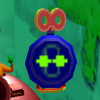 Bombs |
Disengaged Bob-ombs that can be picked up and tossed. They explode on impact. Bombs are necessary to defeat Monty Mole. |
 Springboards |
Springboards that can be picked up and carried by Mario. They are too large to be carried by default, but shooting them with water causes them to shrink. |
 Water rockets |
Tiny, projectile missiles that are equipped to FLUDD's nozzle when touched. They are used on Pinna Park's roller coaster to damage Mecha-Bowser and pop balloons. |
 Yoshi Egg |
A spotted green egg that contains Yoshi. Bringing the egg a specified fruit will cause Yoshi to hatch from the egg and be available to ride. |
Power-ups
These are replaceable nozzles for FLUDD that give Mario unique abilities.
| Nozzle box | Nozzle | Effect | Description |
|---|---|---|---|
| N/A |  Squirt Nozzle |

|
FLUDD's default nozzle and the only one that cannot be swapped out for another. It allows Mario to spray water in front of him, like a hose. The amount of pressure applied to the |
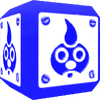 Hover Nozzle box |
 Hover Nozzle |

|
Dual nozzles available from the start of the game, but can be swapped with the Rocket or Turbo Nozzles. It allows Mario to hover above ground for as long as the |
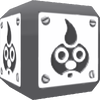 Turbo Nozzle box |
 Turbo Nozzle |

|
A nozzle unlocked in Delfino Plaza after twenty-five Shine Sprites have been collected and Yoshi has been unlocked. It allows Mario to run at an incredibly fast speed over land or sea. He can turn much more easily over water than on land. |
 Rocket Nozzle box |
 Rocket Nozzle |

|
A nozzle unlocked in Delfino Plaza after thirty Shine Sprites have been collected and the Turbo Nozzle has been unlocked. It allows Mario to launch himself high into the sky. |
Yoshi's fruits
Six varieties of fruit can be found on the ground and growing in trees on Isle Delfino. With the exception of the durian, which can only be kicked around like a soccer ball, all fruits can be picked up and carried by Mario. There are a few objectives in the game that require the collection of fruit. A principal function is their effect on Yoshi. Yoshi Eggs will only hatch when a specified desired fruit is brought to them. Whichever one is requested determines the properties of Yoshi's juice. Spraying enemies with juice turns them into Yoshi Platforms and how they move correlates with the type of juice they were sprayed with. The player can change the type of juice sprayed by simply eating a different fruit. This is all communicated by the color of the juice and Yoshi's skin. Despite appearing green in promotional artwork for Super Mario Sunshine, he only appears as such briefly once his juice tank is depleted or he has fallen into water.
| Fruit | Color | Yoshi Platform | Description |
|---|---|---|---|
 Papaya  Pineapple |
 Orange Yoshi |
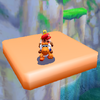 Orange platform |
Papayas and pineapples turn Yoshi orange. Enemies sprayed by his juice become stationary platforms. |
 Banana  Coconut |
 Pink Yoshi |
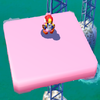 Pink platform |
Bananas and coconuts turn Yoshi pink. Enemies sprayed by his juice become platforms that vertically ascend. The platforms do not come back down. They only stop their ascent once they turn back into enemies. |
 Durian  Pepper |
 Purple Yoshi |
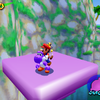 Purple platform |
Durians and peppers turn Yoshi purple. Enemies sprayed by his juice become platforms that move horizontally. The platforms continuously move in one direction, not back-and-forth. |
Objects
Objects are interactable elements of the environment that cannot be picked up or collected by Mario. For objects that primarily function as obstructions or hazards, see above.
| Name | Description | |
|---|---|---|
| Strikable and sprayable objects | ||
Balloon[18] |
Large pink balloons. Twenty appear in "Roller Coaster Balloons", during which Mario must burst them all with water rockets to be awarded a Shine Sprite by the ride operator. They resemble Bowser Jr. | |
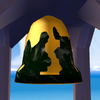 Bell[19] |
Brass chimes. Spraying one with water releases coins and other items. The giant bells of Delfino Plaza are covered in goop. One releases a Shine Sprite when cleaned. | |
 Clam Cups[20] |
A spinning ride at Pinna Park. A clam opens up when sprayed. The green one contains a blue coin. | |
Closet |
Four wooden closet panels in Hotel Delfino. Spraying a panel will cause it to spin depending on how long it was sprayed, and settle on one of its two sides. One side of each panel displays part of a Boo's silhouette, and completing the image makes the panels part, revealing access to a new room. | |
 Dune Bud |
Little plants endemic to Gelato Beach. Spraying one with water causes it to erupt into a giant sand sculpture for a brief period of time. | |
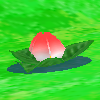 Flower |
Spraying a flower causes its petals to open and release a coin. Some are rooted in circles: causing all of the flowers in the circle to bloom releases a lot of coins. Some flowers are buried Pokey Pods that emerge from the earth when sprayed. | |
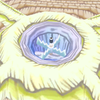 Jumbo juicer |
A large juicer built into the roof of the Surf Cabana. It is used during The Watermelon Festival to turn watermelons into smoothies. Bringing a watermelon to the jumbo juicer releases a Shine Sprite. | |
 M Graffiti |
The insignia of Shadow Mario painted across Isle Delfino. Clearing the insignia usually procures a blue coin. The only exception is at the Delfino Airstrip, where M Graffiti release yellow coins. Graffiti appears in other contexts, such as on poster in Hotel Delfino. Clearing the graffiti reveals an entrance into a different room. Spraying obscured Shine Paintings releases a blue coin or Shine Sprite. | |
 Nail |
Iron nails embedded into wooden blocks. Ground pounding one into the block produces an item. They only appear in secret courses. | |
 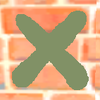 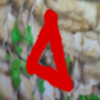 Paired Graffiti |
A pair of painted symbols. Potential symbols include ◯, ✕, and △. Both members of a pair are of the same symbol. In courses, they are distant from each other and they are not denoted on any in-game map. When a symbol is cleared, a blue coin is released from its paired counterpart for a limited period of time. If Mario does not collect the blue coin in time it vanishes and the symbol reappears. This allows the player to attempt to clear Paired Graffiti as many times as they need. | |
 Puzzle[21] |
A tile-based matching game. Spraying an individual tile flips it. Flipping every tile creates the picture of a Shine Sprite and unlocks access to a pipe. Water cascades when sprayed and this makes it difficult to flip the highest tiles without undoing the lower ones. | |
 Red Switch Plate[22] |
Red switches. When ground pounded, eight Red coins appear for a limited period of time. | |
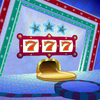 Slots |
Spraying a roll on the machine causes it to spin. Getting three of the same picture on a roll triggers a certain effect. Getting three 7s on all slot machines is necessary for progression. | |
 Stone slab |
A stone cylinder adorned with a meteor symbol. Flying high into the sky with the Rocket Nozzle and performing a ground pound breaks the stone slab. | |
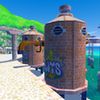 Tank[23] |
Large vats that contain fruits. Ground pounding the top of one causes a fruit to be released from its pipe. | |
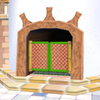 Turbo-bashable doors |
Doors that block entrances to new areas and items of interest. Running into them with the Turbo Nozzle breaks the doors. | |
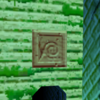 Wall painting |
Ancient switches in Noki Bay. Spraying a switch either causes parts of the terrain to move for a limited period of time, or makes an item of interest appear. Some switches have abstract designs carved into them. | |
Wanted poster[24] |
The wanted poster of Shadow Mario posted around the island. Spraying one expels an item of interest from the wall it is posted on. | |
 Watermelon |
Big green fruit. A watermelon is rolled when sprayed but can fall apart if it rolls off of an edge. They cannot be eaten by Yoshi. | |
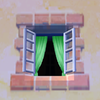 Window |
Opened windows. Spraying into one releases a coin. | |
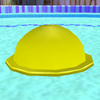 Yellow Switch Plate[22] |
A yellow switch. Ground pounding one causes many coins to appear for a limited period of time. | |
| Climbable objects | ||
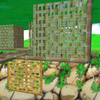 Gate |
Bamboo panels hanging from tracks underneath Pianta Village. Smacking a gate with | |
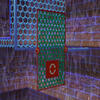 Green panel[25] |
A flippable green panel. Spraying one with water rotates it 90°. | |
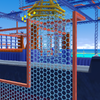 Metal screen |
Climbable walls and ceilings of mesh. | |
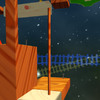 Pole |
Climbable poles. Mario clings to one by jumping onto it. He can ascend, descend, and change which face of the pole he is on by moving | |
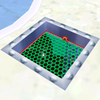 Revolving Gate |
Flippable metal screen panels. Some are embedded into walls, while others are in the ground. Striking the walled grates spins Mario to the other side. Ground pounding one brings Mario to the other side and automatically holding onto the metal screen. Pressing | |
 Tree |
Palm trees. Most function similarly to poles. Palms with thick leaf bases are too wide to climb straight to the top. Some bear fruit, like coconuts or bananas, that fall when sprayed. An unclimbable deciduous tree in Pianta Village bears all six fruits. | |
| Blocks and platforms | ||
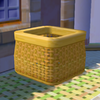 Basket[26] |
Woven fruit baskets. They sometimes contain times of interest. In Delfino Plaza, there are baskets owned by Piantas. Tossing three of their fruit of choice into their basket rewards Mario with a blue coin. | |
 Blue and yellow blocks [conjectural] |
Blue and yellow blocks that turn clockwise and counterclockwise. | |
 Boat |
Freight gondolas that move through the canals of Delfino Plaza. They have consistent and predictable paths that bring them to distant islands. | |
 Brick Block |
Blocks. They fall apart when hit from below. | |
 Cloud |
Platforms that float in the air. | |
 Crate |
Wooden boxes that contain items. They release their contents when ground pounded. | |
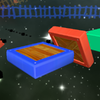 Flipping platforms |
A pair of red and blue panels attached to a track. They move and flip in a fixed path. | |
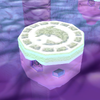 Float [conjectural] |
Platforms that sink in water when stepped on, then rise back up. | |
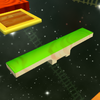 Green block[27] |
A long thin platform that spins. | |
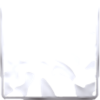 Ice block |
Ice cubes. They melt when sprayed with water. | |
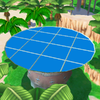 Mirror |
Giant solar mirrors that direct heat towards the Sand Bird's incubating egg. Plungelos plateau the mirrors, allowing Mario to walk on them. | |
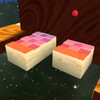 Multicolored block[27] |
Long, rectangular platforms that slide in and out of walls. | |
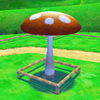 Giant mushroom |
Tall mushrooms. The red ones are lit with fire like lanterns. There are two green-capped mushrooms called Jump Mushrooms that can be bounced on like a trampoline. | |
 Orange block |
Blocks that contain nothing and cannot be broken. These blocks primarily appear in secret courses as platforms and barriers. Many are of atypical shapes (i.e. rectangular or triangular prisms) depending on their purpose. Some shift back and forth. | |
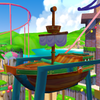 Pirate Ship |
A pair of swinging ship rides at Pinna Park. | |
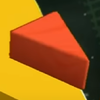 Red triangle[28] |
Red triangular platforms that move in one direction. | |
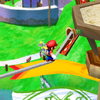 Rope |
Tightropes stretched across distant platforms. Mario can carefully walk across one or launch himself high into their air. | |
 Sand block |
A block of sand that crumbles when stepped on. They reappear after a brief period of time. The Sand Bird is made out of these blocks, though the blocks making up its body do not crumble. | |
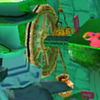 Scale |
A platform attached to a pulley system. Filling the attached jug with water causes the platform to rise. The jugs are cracked and slowly leak water, causing the platform to lower. | |
 Spotted block |
Polka-dotted block platforms found in secret courses. They move back and forth in some courses. | |
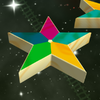 Star[29] |
Rotating star-shaped platforms. | |
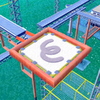 Trampoline |
Platforms that bounce Mario high in the air. Ground pounding the surface of a trampoline launches Mario higher. | |
 Vanishing block[30] |
Green or red block platforms that phase in and out of existence. If one disappears while Mario is on top of it, he will fall through the space it occupied. | |
 Watermelon block |
Cube-shaped watermelons. Jumping underneath one breaks it. | |
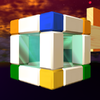 White box |
Giant cube-shaped platforms. | |
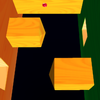 Yellow peg[31] |
Long rectangular platforms move side-to-side. | |
| Transportation objects | ||
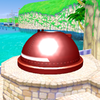 Cannon |
Red turrets that launch Mario to distant areas. They are accessed like a pipe. In Pinna Park, the cannon brings Mario to a secret course. | |
 Fluff |
Dandelion seeds that are carried by the breeze. Mario can grab onto a Fluff by pressing | |
 Hook |
Iron hooks attached to red and white poles. Mario can grab onto one by pressing | |
Leaf boat |
Boardable lily pads that float in bodies of water. Mario can propel one and direct its trajectory by spraying water. In some episodes, leaf boats are in polluted water and slowly break down when boarded. | |
  Manhole cover |
Sewer holes found across Isle Delfino. They can be used as entry ways to elaborate sewage systems by performing a ground pound above one. | |
 Mudboat |
A boardable boat. Mario can direct them like leaf boats. Mudboats remain intact in polluted water and are durable enough to float in magma. | |
Portrait (Boo) |
A painting of a sunset that makes a nearby Pianta unsettled. Spraying it exposes an image of Boo and allows Mario to jump through it to access a new room. | |
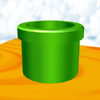 Pipe |
Pipes going through the ground that transport Mario to new areas. | |
 Roller Coaster[18] |
The Koopa-shaped coaster car in Pinna Park. It will automatically move through the course when boarded. The boss battle against Mecha-Bowser occurs aboard this car. | |
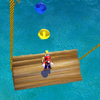 Swing |
Wooden swings. Spraying while on top of the seat pushes it and makes it move back and forth. Jumping at the apex of the swing allows Mario to reach higher areas. | |
| Wildlife | ||
 Butterflies |
Winged insects that can be eaten by Yoshi. Different colored butterflies yield different collectibles when eaten: yellow ones produce coins; blue ones produce blue coins; and green ones produce 1-Up Mushrooms. They can typically be found in groups around patches of flowers. | |
 Birds |
Small, crested parrots found throughout Isle Delfino. Spraying them with water will transform them into a collectible that is dependent on the bird's color. Green Birds turn into coins, Blue Birds turn into blue coins, Gold Birds turn into Shine Sprites, and Red Birds turn into red coins. | |
 Fish |
While most fish are decorative elements that cannot be interacted with, two species provide hints in the shallows of Gelato Beach. Schools of the blue fish swim around blue coins. Schools of the red fish surround hidden red coins during "Red Coins in the Coral Reef". | |
| Other objects | ||
 Arrow sign |
Signs that passively guide the player towards the intended focus of the episode they enter. In most instances, Mario can still go off the intended path. | |
 Sign |
Posted signs that contain information on actions. | |
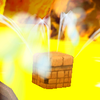 Spring of water[32] |
Sprung water, often shooting out of blocky terrain, small pipes, and fountains. Mario can refill FLUDD's tank when he stands in the stream. | |
 Yoshi-Go-Round |
A carousel at Pinna Park. | |
Differences from other 3D Super Mario platformers
- This is the only 3D Super Mario platformer in which Peach's Castle does not appear, as well as one of three 3D Super Mario platformers that do not begin with Princess Peach sending Mario a letter (the other two being Super Mario 3D World and Super Mario Odyssey).
- This is one of only two 3D Super Mario platformers where Princess Peach is not kidnapped at the very beginning of the game, with the other being Super Mario 3D World (where she is not kidnapped at all, as she is one of the playable characters).
- This is also the only 3D Super Mario platformer that does not include Goombas or Koopa Troopas as enemies. However, Strollin' Stus act very similarly to Goombas, and two subspecies of Koopa Troopa appear in the game (Electro-Koopas and Snooza Koopas).
- This is one of only two 3D platformer games in the Super Mario series not to feature Luigi, the other being Super Mario 64 (though he does appear as a playable character in Super Mario 64 DS).
- This is the only main Super Mario game to date not to feature any sort of item or function that grants temporary invincibility.
- This is the first and only 3D Super Mario platformer where Mario cannot perform the Long Jump or Crouch.
- This is the only 3D Super Mario platformer in which Mario fights against Bowser (or his impostor) only once during the storyline. In most of the others, Mario and Bowser fight three times.
- This is one of three 3D Super Mario games where Mario does not say "Thank you so much for playing my game!" at the end of the credits, the others being Super Mario 3D Land and Super Mario 3D World.
Regional differences
Cutscenes
Despite cutscenes in the Japanese release using English voice acting, there are a few differences compared to International releases early in the game. Mario's conversation with Toadsworth is audible, with a few unsubtitled remarks. After getting out of the plane, Mario says "It looks like a giant empty plate" and "Oh no! We're going to be late for dinner!"; later in the same cutscene, when Peach notices that Shadow Mario is gone, Mario can be heard saying "Looks like Mario's gonna have to find a job" in the background, to which Toadsworth responds with "Trying to start a new career?" before quickly changing the subject. Soon afterwards, in the court cutscene, the prosecutor uses an alternate take in which he mispronounces "Shine" as "Shrine" three times, refers to "Isle Delfino" as "Delfino Isle", and mispronounces "aware" as "of where" once. His tone is also distinctly different, sounding much less stern.
In addition, there is no option to turn off the subtitles (likely due to it being Japanese, but with English voices).
Location names
The Japanese version has different names for the locations in the game.
- Isle Delfino is called Dolphic Island.
- Delfino Airstrip is simply named Airport.
- Delfino Plaza is named Dolphic Town.
- Gelato Beach is named Mamma Beach.
- Noki Bay is named Mare Bay.
- Pianta Village is named Monte Village.
In cutscenes, the names of Isle Delfino and Delfino Plaza are the same as in the later English localization (as are the characters Bowser, Toadsworth and FLUDD), although they are altered in the subtitles.
Other changes
- The "Press Start" on the title screen was moved to the top corners of the logo in the American version, while it is at the bottom of the screen in the Japanese and PAL versions.
- Audio delay (such as when Shadow Mario appears in Delfino Plaza) is removed from the international versions.
- When racing Il Piantissimo in international versions, a unique music theme plays. In the Japanese version, the level theme still plays.
- A small voice clip from Mario when exiting a Rainbow M is absent in the Japanese version.
- If Mario collects his 100th Delfino Plaza coin in the Red Coin Field, the Japanese version locks up because it does not know where to spawn the resulting Shine Sprite. A spawn point was added to international versions and thus the game no longer locks up there.
- The button icons are less generic in international versions and actually resemble GameCube controller buttons.
- The small text on the map screen was rewritten and made thicker.
- When jumping off Yoshi, Mario jumps straight above him in the Japanese version while he dismounts behind him in international versions. This is to fix a glitch where Mario can clip through ceilings by jumping off Yoshi.
- The preview cinematics for Bianco Hills, Ricco Harbor and Gelato Beach were changed in international versions, with the camera generally making wider circles in the Japanese versions. This led to some noticeable jump-cuts in the Bianco Hills preview.
- In Scrubbing Sirena Beach, Mario has to clean 99% of the goop in the Japanese version but only 95% in international versions.[33]
- The small text on signs is in English in the Japanese version and in an abstracted Latin alphabet[34] in international versions.
- Fruits were added to Delfino Plaza's fountains in the international versions to make feeding Yoshi easier.
- When losing a life, "Miss!" appears instead of "Too Bad!" in the Japanese version, and when gaining a Shine Sprite, "Shine Get!" appears instead of "Shine!".
- When Yoshi almost runs out of juice before disappearing, the text "Hungry" appears in the Japanese version. In the international versions, it says "Fruit".
- PAL versions have additional differences from all NTSC versions. Only NTSC versions can be played in progressive scan mode, and only PAL versions can be played in 50Hz mode, using the same method to activate each. The American and Japanese versions have their languages locked to English and Japanese, respectively, while the PAL version can additionally be played in Spanish, French, Italian and German depending on the GameCube settings.
Staff
- Main article: List of Super Mario Sunshine staff
Yoshiaki Koizumi served his first directorial role for this game alongside Kenta Usui. Koizumi previously worked as the assistant director for Super Mario 64. Shigeru Miyamoto and Takashi Tezuka worked as the game's producers. This is the first Super Mario game that credits Satoru Iwata as the executive producer.
The extensive voice-acting cast includes Charles Martinet reprising his role as Mario, Jen Taylor reprising her role as Peach and the Toads, Dolores Rogers and Kit Harris as the new characters Bowser Jr., and FLUDD respectively, and Scott Burns as Bowser, the first game (and only Super Mario game) in which Burns lends his voice to the character.
Development
When creating the premise for Super Mario Sunshine, Yoshiaki Koizumi was influenced by childhood memories such as the experience of a hero jumping from rooftop to rooftop for Delfino Plaza and playing in water for FLUDD and the general gameplay.[35] By the time he submitted the basic proposal to Shigeru Miyamoto, he had already thought of Mario utilizing a water pistol as the primary mechanic. They imagined why Mario would have the water pistol, which led to the inclusion of the graffiti elements.[36] During development, Koizumi created a clay model of Isle Delfino.
Reception
Super Mario Sunshine received widespread critical acclaim, currently holding an aggregate score of 91.50% on Gamerankings based on 76 reviews.[37] While praise was directed towards the wide array of moves, criticism was directed towards the camera, the gimmicky nature of FLUDD and the Yoshis, and the game's voice acting. Super Mario Sunshine is the 3rd best selling game for the Nintendo GameCube as it sold about 6.3 million copies as of December 31, 2009, and was the 10th best selling game of 2002, according to the NPD.[38]
Mario's voice actor, Charles Martinet, considers the game to be an "underrated game".[39]
| Reviews | |||
|---|---|---|---|
| Release | Reviewer, Publication | Score | Comment |
| GCN | Fran Mirabella III, IGN | 9.4/10 | "At the end of the day, though, Super Mario Sunshine is about gameplay. Its depth easily passes by all of the problems with presentation, sound, and visuals. If Super Mario 64 is one of your favorite games, then I'm confident Super Mario Sunshine will be added to that list." |
| GCN | Jeff Gerstmann, GameSpot | 8/10 | "While some gamers will be able to look past or even embrace the fact that Super Mario Sunshine sticks extremely close to Super Mario 64's formula, others will find that the game suffers from a lack of innovation. The game's technical issues and often-gimmicky design are still tougher to ignore, and they combine to make the game seem surprisingly unpolished and somewhat rushed at times. In the end, though, there's enough in Super Mario Sunshine to warrant a purchase, particularly when you consider that there really aren't any decent platformers to be found on the GameCube and that this really is the only new Mario game out there." |
| GCN | Brad Long, Nintendo Life | 9/10 | "Though it's not exactly the Mario game everyone was thinking of when it came out, much like the Legend of Zelda: Wind Waker wasn't as expected, it's still a classic Mario title that's definitely worth having in your collection if you're a fan of the ol' plumber, or platforming games in general. It's a shame that there couldn't have been more variety in the levels, but there's a great deal of fun to be had in this title. Anything else that could set it back isn't really a deal-breaker." |
| Aggregators | |||
| Compiler | Platform / Score | ||
| Metacritic | 92 | ||
| GameRankings | 91.50% | ||
Super Mario 3D All-Stars description
- "Mario and friends have arrived on Isle Delfino, ready to enjoy a relaxing vacation. Instead, they find that someone has polluted the island with icky, goop-like graffiti! Framed for this terrible crime, Mario must clean the island, find the true culprit, and reclaim the Shine Sprites—Delfino's sunny energy source—that have hidden themselves to escape the mess. Using the power of the Nintendo GameCube system, this game offered dazzling water effects and a slick set of moves for Mario through his new tool, FLUDD."
Pre-release and unused content
In Super Mario Sunshine, Delfino Plaza is the main plaza of the game. However, in trailers before release, it showed that there was going to be a different plaza (or a possible early Delfino Plaza), with a giant Strollin' Stu-like creature called Hinokuri walking around the place and many more different things.
A pre-release video also reveals that humans were intended to be citizens of the plaza. FLUDD was going to be skinnier. Gooper Blooper was going to be dark blue and fought on top of the bridges of Ricco Harbor instead of in the market and helicopter area.
An unused human citizen of Isle Delfino.
Notable mistakes and errors
- After Toadsworth asks Mario to find some assistance, Mario says "Mmm-hmm" and turns to face the camera. During this scene, if the player looks closely at Mario's eyes, they are too far apart, mostly due to a position error.
- In the first shot of Delfino Airstrip after the landing, Peach is behind Mario. When the camera zooms in on Mario and Toadsworth as they converse, Peach is behind Toadsworth.
- Whenever Peach speaks, the corners of her mouth (outside the lipstick area) do not move at all. Only the center of her mouth (inside the lipstick area) moves when talking.
- In the first two close-ups of Mario and Toadsworth at Delfino Airstrip, Peach's earrings use her eye texture.
- When Mario goes to a place with a mirror such as Gelato Beach, he can look into a mirror and see that FLUDD's head seems to be missing in the reflection.[40]
- When the lighthouse leading to Gelato Beach is covered by paint, the block that normally sits on top of it is still there, floating in the air.
- When Delfino Plaza is flooded, the manhole cover underneath the southwestern bell tower is missing, leaving just the manhole. As it is inaccessible during this period, it does not affect gameplay. The manhole cover may not, however, be completely gone, as a manhole cover mysteriously appears inside the jail at the southeastern bell tower.
- When Delfino Plaza is flooded, Purple Toad is wearing a blue vest, similar to Blue Toad. No other Toad's vest changes.
Glitches
- Main article: List of Super Mario Sunshine glitches
Blasting through the wall
The player must first get the Turbo Nozzle and then head to the fruit stands. While standing slightly against the wall behind the papayas and pineapples (Mario's body should touch the wall, but he should not be directly facing it), Mario can blast his Turbo Nozzle, and before reaching the durians, he will pass right through it into an underground area. If Mario stops, he automatically dies, but it is possible that Mario might come across an underground pipeline to run into.
Game resets itself
In Blooper Surfing Safari, first, Mario must pick a Blooper from the floating platform. As he navigates himself to the tunnel with the pollution, Mario must enter the tunnel, but only before the screen changes to the Blooper race course inside the tunnel. Just as he enters, the player must pause the game and select, "EXIT AREA." He will then enter the tunnel, but instead of entering the Blooper race course, the game will reset itself. This works everywhere that Mario goes to another part of the level.
Yoshi's slippery saddle
In Hotel Delfino, Mario must hop on a Yoshi and enter the attic. If Mario runs into a Sleepy Boo, he flies off the Yoshi as usual, but if he tries to jump on the Yoshi again, he falls off the Yoshi again. Mario cannot jump on the Yoshi again unless he goes downstairs to get the Yoshi again or if Mario takes damage and then jumps on it.
Quotes
- Main article: List of Super Mario Sunshine quotes
Bowser
- "Bwaaaa ha ha! The water's great, eh, Jr.?"
- "Mario! How dare you disturb my family vacation?!"
- "Jr., I've got something...difficult...to tell you about Princess Peach..."
- "That's my boy! Well put, son! The royal Koopa line is strong as ever! But for now...let's just rest awhile."
Sunglasses vendor
- "I love the sunshine, but OOOH! Is it ever bright!"
- "Here, little man. Try a pair of my special sun shades. They're cool!"
- "Yeah heh heh... You're styling now!"
- "Come back and talk to me when you don't need them anymore."
- "Hey! Sun shades alone just won't cut it for you. Nope!"
- "You also need one of my custom tropical shirts. Here you go!"
- "My, oh my! I haven't seen anyone look that good in my gear in ages!"
- "Come see me again when you want to return them, OK?"
- "You had enough? Come by anytime if it's too bright for you, OK, little man?"
Appearances in other media
Super Mario Sunshine has been adapted into numerous comic books. It was the subject of a story arc spanning volumes 28, 29, 30, and 31 of Super Mario-kun.
Super Mario Sunshine was made into a manga of the same name as part of the 4-Koma Gag Battle series. The game was also made into a manga published by Futabasha Publishers Ltd. as part of the 4koma Manga Kingdom series.
Volume 31 of Super Mario-kun
Gallery
- For this subject's image gallery, see Gallery:Super Mario Sunshine.
Principal characters at Delfino Plaza, running from Shadow Mario
Wallpaper of Gelato Beach
Shadow Mario kidnapping Princess Peach
Media
- For a complete list of media for this subject, see List of Super Mario Sunshine media.
| File info 2:43 |
| File info 0:30 |
| File info 0:30 |
| File info 0:30 |
References to other games
- Mario Bros.: When FLUDD scans Mario during its malfunction after the fight with Bowser, a black-and-white screenshot from this game is shown with the text "GAME OVER" just before its video crashes.
- Super Mario Bros.: Right before the game starts, an 8-bit coin sound effect is played on the Nintendo logo screen. Also, covers of the main Super Mario Bros. theme, as well as the underground stage theme, are featured in the game. Additionally, the secret courses in Episodes 4 and 9 of Ricco Harbor, as well as Episodes 2 and 9 of Sirena Beach has a background that display many giant 8-bit Marios. Also, at the beginning of the game, it is possible to see three "memories" of Mario in the lower left-hand corner. The first of the three is a NES video of Mario approaching a fake Bowser on the iconic bridge (although it could just as easily have been a Disk System recording of Super Mario Bros.: The Lost Levels).
- Super Mario World: When FLUDD scans Mario, the second video shows the SNES boss fight with Iggy Koopa. Also, the ability to climb on gates and punch enemies from the inside of it originated from this game, as well as riding on Yoshi, as well as the added drums in the background music when Yoshi is being ridden on. Finally, the regular boss music is a cover version of the final boss music against Bowser from Super Mario World.
- Super Mario All-Stars: The head of the sprite for the idle animation of Small Mario from Super Mario Bros. and Super Mario Bros.: The Lost Levels in this version is used as an icon to locate Mario's position in Delfino Plaza on its informational box of the Guide Book.
- Super Mario World 2: Yoshi's Island: The secret courses in Episodes 2 and 9, as well as Episodes 6 and 10 of Pinna Park has unique backgrounds in the style that is reminiscent to that of this game's graphics.
- Super Mario 64: The number of Shine Sprites in Super Mario Sunshine is the same number of Power Stars in Super Mario 64. Also, the way Mario enters Noki Bay is very similar to the way Mario enters the Tower of the Wing Cap in Super Mario 64. When FLUDD scans Mario, the last video depicts Mario swinging Bowser by the tail in Bowser in the Dark World. Most of Mario's animations are reused, while others are new. The player's head can get stuck in sand similar to getting Mario's head getting stuck in the sand or the snow in this game. The music played when Mario and Peach are watching the sunset is a remake of Peach's usual theme when she is rescued.
- Yoshi's Story: The idea of eating fruits to keep Yoshis healthy is similar in this game.
- The Legend of Zelda: Ocarina of Time: Il Piantissimo looks like the running man under his mask. Additionally, the Versus Books guide refers to one of the landmarks of Pinna Park - the Pianta-shaped, Papaya-bearing tree - as the Deku Tree.
- Luigi's Mansion: FLUDD and the magic brush are inventions of Professor E. Gadd. During the third episode of Sirena Beach, one of the employees in the hotel claims that the ghosts are annoying and wishes that "Someone would come and suck them away with a vacuum or something" and then asks Mario "Why are you looking at me like that?". When Mario tries to open locked doors in Hotel Delfino, he makes a similar grunt to the noise that Luigi makes in the same situation in this game.
References in later games
- Mario Golf: Toadstool Tour: Many of the enemies' names from this game appear on the scoreboards in Tournament mode, such as Phantamanta, Poink, Cataquack, and Plungelo. The Blooper Bay course also bears a minor resemblance to Gelato Beach. Lastly, this game marks the first time Petey Piranha, Bowser Jr, and Shadow Mario appear as playable characters.
- Mario Kart: Double Dash!!: Shine Sprites were included in this game in the Shine Thief battle mode. The stage Peach Beach resembles Delfino Plaza and contains Cataquacks, and Piantas and Nokis also appeared. Bowser Jr. is a default playable character, and Petey Piranha is also an unlockable pair of characters. Part of the Delfino Plaza theme can be heard during the award ceremony music. The background of Tilt-a-Kart somewhat resembles that of the secret courses in The Secret of Ricco Tower and The Hotel Lobby's Secret as it also display many 8-bit Marios.
- Mario & Luigi: Superstar Saga: The fourth difficulty of the Border Jump minigame is titled "Super Border Jump Sunshine."
- Mario Golf: Advance Tour: Same as Mario Golf: Toadstool Tour, except for course and playable characters. The Shine Sprite item was included in this game. Also, some of Mushroom Tourney bears a minor resemblance to Bianco Hills.
- Paper Mario: The Thousand-Year Door: Shine Sprites and Piantas made an appearance in this game, but they had an entirely different purpose. Also, Doopliss's parrot will say the phrase, "Shine Get!", which is the phrase that appears after Mario gets a Shine Sprite in the Japanese version of Super Mario Sunshine.
- Mario Power Tennis: The court Delfino Plaza comes from this game and the Gooper Blooper Court takes place in Ricco Harbor. Also Mecha-Bowser, Bowser Jr. and Petey Piranha reappear in this game.
- Mario Party 6: The bees on Towering Treetop bear the same design they had in Super Mario Sunshine.
- Super Mario 64 DS: A new beach stage called the Sunshine Isles plays a version of the Delfino Plaza music in the background. The acapella cover of the Super Mario Bros. theme from the secret levels appears in this game can also be heard in two of Mario's mini games. A version of the Hotel Delfino casino theme plays during Luigi's casino minigames, only with the whistling and saxophones removed.
- Mario Superstar Baseball: One of Mario's team names is the Mario Sunshines, referencing this game.
- Mario Kart DS: A new stage was named Delfino Square in reference to Delfino Plaza. Also, there is a battle mode, Shine Runners, where the player has to collect the most Shine Sprites in the time given.
- Super Princess Peach: Petey Piranha, Gooper Blooper, and Wiggler must be defeated in similar ways to their battles in this game.
- Mario & Luigi: Partners in Time: The Shine Sprites make an appearance in this game. The Mario Bros. have to hit them to get some light for a limited time in dark areas where the Baby Bros. go. Also, Petey Piranha appears as a boss in the game.
- New Super Mario Bros.: The minigame Trampoline Time has the same music as the secret levels in Super Mario Sunshine and Bowser Jr. is the second antagonist again.
- Super Paper Mario: A Sammer Guy exists who calls himself "Sunshine Flood".
- Super Mario Galaxy: Fire Shooters and Water Shooters, which appear in various galaxies, appear very similar to FLUDD's nozzle. Also, Cataquacks make a few appearances as helpful enemies to get Power Stars. A toy robot-like Bowser is called Mecha-Bowser as a reference to the Pinna Park boss.
- Super Smash Bros. Brawl: Mario can use F.L.U.D.D. in this game to spray his opponents. Also, Delfino Plaza appears as a selectable stage. The themes for Delfino Plaza and Ricco Harbor appear as selectable music for the aforementioned stage. Petey Piranha is the first boss in the Adventure Mode. Several stickers and trophies are of characters who debuted in this game.
- Mario Kart Wii: The race course Coconut Mall as well as the battle course Delfino Pier, which are references to Super Mario Sunshine, appear in this game. Piantas and Nokis can also be seen watching the racers.
- Mario & Luigi: Bowser's Inside Story: A Shine Sprite appears in this game as one of the ranks for Mario and Luigi.
- Super Mario Galaxy 2: The Starshine Beach Galaxy is based on the motifs of Sunshine, such as the Grand Pianta Statue, and makes several references to the game. Piantas return as non-playable characters in said galaxy. In addition, the Twisty Trials Galaxy is based almost-exactly on the Secret of Ricco Tower level.
- Super Mario 3D Land: Tightropes are featured as a game mechanic similar to this game's ropes. The cutscene with Bowser and Mario before the final boss fight mimics the cutscene before the first Petey Piranha fight, with the floor cracking, Mario and Bowser looking around, and falling into the battle area after the floor collapses.
- Mario Kart 7: As Piantas are removed entirely on any Mario Kart: Double Dash!! retro track in Mario Kart 7, the only reference that exists of Super Mario Sunshine is a single advertisement board at the side of Dino Dino Jungle, displaying the words "Sunshine Parts" with a Shine Sprite as the background. This is because Dino Dino Jungle appears as a retro track from Mario Kart: Double Dash!! in the game. Wii Coconut Mall also reappears but with the physical Piantas removed as well, leaving only the ones in the logos to appear.
- Paper Mario: Sticker Star: One of the questions in "Snifit or Whiffit" is "Bowser is Bowser Jr.'s Dad, and Princess Peach is his mother", which might be a reference to this game. Also, Gooper Blooper appears as the World 3 boss. Lastly, Petey Piranha's belly button is once again his weakness.
- Mario Kart 8: Sunshine Airport has a Shine Sprite for its logo, and it takes place on a tropical island. The European release date for this game (Oct 4th, 2002) is used as a serial number on some storage crates (55402MS).
- Mario Kart 8 Deluxe: The sound of King Boo being hit by a pepper is used for King Boo's horn. Shine Sprites appear again in the Shine Thief battle mode. Coconut Mall returns as a classic course, and the Piantas have been re-added to the course.
- Super Smash Bros. for Nintendo 3DS / Super Smash Bros. for Wii U: Delfino Plaza reappears as a Past Stage in the Wii U version of this game as well as the two themes used in the stage: Delfino Plaza and Ricco Harbor. Shadow Mario and the magic brush appear as part of Bowser Jr. and the Koopalings' Final Smash Shadow Mario Paint.
- Mario & Luigi: Paper Jam: Petey Piranha can spit goop at the Mario Bros. like in this game.
- Paper Mario: Color Splash: There is a character called Petea Piranha that looks and attacks exactly like Petey Piranha.
- Super Mario Odyssey: The Gushen enemies function very similarly to F.L.U.D.D.'s Hover and Turbo Nozzles. In an update, an outfit based on the outfit Mario obtains from the sunglasses vendor can be worn.
- Super Smash Bros. Ultimate: Delfino Plaza stage returns. A Shine Sprite, Shadow Mario, Piantas, and F.L.U.D.D. appear as spirits by using their artwork from Super Mario Sunshine. An arrangement of Delfino Plaza music appears in the game.
- Mario & Luigi: Bowser's Inside Story + Bowser Jr.'s Journey: If set to a ranged type, Bowser Jr. uses his magic brush as his weapon.
- Super Mario Maker 2: The "Delfino Plaza" theme is featured in this game as a sound effect under the "Musical" category, represented by the GameCube logo.
- Mario Kart Tour: The Sunshine Parts sponsor returns in several courses in the game. Coconut Mall also returns as a classic course.
- Super Mario 3D World + Bowser's Fury: Bowser Jr. wields the magic brush. Mario encounters Shadow Mario's M Graffiti on the ground during the opening cutscene for Bowser's Fury. The way Mario chases the Fury Shadows to get a Cat Shine is similar to how he has to chase Shadow Mario to get a Shine Sprite.
- Splatoon 3: The character Big Man has a boss fight where he transforms into a shadow manta, alluding to the Phantamanta boss fight on Sirena Beach. Big Man's ink is also the same turquoise and yellow coloration as the Phantamanta's electric goop. The drum beats that signify the onset of his boss fight are also nearly identical to those that play at the beginning of the "Boss Battle" theme.
- Super Mario Bros. Wonder: The music "Isle Delfino" and "Secret Course" return in this game.
Names in other languages
| Language | Name | Meaning | Notes |
|---|---|---|---|
| Japanese | スーパーマリオサンシャイン[?] Sūpā Mario Sanshain |
Super Mario Sunshine | |
| Chinese (simplified) | 超级马力欧阳光[41] Chāojí Mǎlì'ōu Yángguāng |
Super Mario Sunshine | |
| Chinese (traditional) | 超級瑪利歐陽光[42] Chāojí Mǎlì'ōu Yángguāng |
Super Mario Sunshine | |
| Korean | 슈퍼 마리오 선샤인[?] Shupeo Mario Seonshain |
Super Mario Sunshine |
Notes
- Sometimes, when losing a life, Mario will say "Arrivederci" which is Italian for "Goodbye". In the German translation, the words "Too bad!" will display as "Arrivederci!".
- The shine on the boxart of the North American, Australian, Japanese, and British versions of this game roughly says, "Mario has more moves than ever, you'll have to master them all to sprinkle / spray water in the sunshine." All the other European boxarts have this sentence as well, but they are translated.
- Super Mario Sunshine is the first Super Mario title to support 5.1 surround sound audio, via the Dolby Pro Logic II encoding system (as the Nintendo GameCube lacks native surround sound support). 21 other games in the series would support the processing technology, with the most recent being Mario Party 9 in 2012. Despite this, it is only the second Super Mario-related title as a whole to support surround sound, being predated by Donkey Kong 64 (which used the earlier, three-channel Dolby Surround encoding system) three years prior.
References
- ^ a b Super Smash Bros. Brawl Chronicle
- ^ Official Mexican Website (Archived). From the Original [1].
- ^ Super Mario Sunshine | Nintendo GameCube | Games | Nintendo UK. Nintendo UK (British English). Retrieved January 18, 2025. (Archived January 19, 2025, 02:41:33 UTC via Wayback Machine.)
- ^ nintendo.com.au - GCN - Super Mario Sunshine. Nintendo of Australia (Australian English). Archived December 2, 2003, 14:53:20 UTC from the original via Wayback Machine. Retrieved January 18, 2025.
- ^ a b Martin Taylor (October 3, 2003). Nintendo bolsters Player's Choice range. Eurogamer. Retrieved November 19, 2024.
- ^ Sakai, Kazuya (Ambit), kikai, Akinori Sao, Junko Fukuda, Kunio Takayama, and Ko Nakahara (Shogakukan), editors (2015). 『スーパーマリオブラザーズ百科: 任天堂公式ガイドブック』. Tokyo: Shogakukan (Japanese). ISBN 978-4-09-106569-8. Page 11–13.
- ^ Nintendo Co., Ltd. HISTORY → Series → Super Mario. Mario Portal. Retrieved 6 Nov. 2024. (Archived October 3, 2024, 11:52:39 UTC via Wayback Machine.)
- ^ a b Reece Goodall. "Sol, praia e os 15 anos de Super Mario Sunshine" (Portuguese text). Nintendo Blast. Published 02 Sep 2020. Accessed 22 Jan 2021.
- ^ Nintendo. "Nintendo Switch Presentation 2017". YouTube. Published 17 Jan 2017. Accessed 30 Jan 2021.
- ^ a b c d Nintendo of Japan. "開発スタッフインタビュー" (Japanese text). Super Mario Sunshine Official Japanese Site. Published 2002. Accessed 30 Jan 2021.
- ^ IGN Staff. "Say Hello to Project Dolphin". IGN. Published 04 May 1999 (Amended errata 21 Jun 2012). Accessed 30 Jan 2021.
- ^ a b Aron Garst. "Super Mario Sunshine Is Nintendo at Its Most Nintendo". Electronic Gaming Monthly. Published 24 Mar 2020. Accessed 30 Jan 2021.
- ^ Redazione Campania. "La Costiera Amalfitana in “Uncharted 4”: nel videogioco uno scorcio di Amalfi" (Italian text). AmalfiNotizie. Published 09 Dec 2017. Accessed 30 Jan 2021.
- ^ Reece Goodall. "Concept to Console: ‘Super Mario Sunshine’". The Boar. Published 22 Jan 2020. Accessed 30 Jan 2021.
- ^ a b Yoshiaki Koizumi. "Super Mario Galaxy: The Journey from Garden to Galaxy". Montreal International Games Summit (archived), Jan. 2007. Recorded by Eric St-Cyr. Compiled by Hover. YouTube. Published 24 Sep 2016. Accessed 27 Feb 2021.
- ^ Bill Trinen. "What's in a Box?". Nintendo Treehouse Log. Tumblr. Published 14 Jun 2017. Accessed 30 Jan 2021.
- ^ a b An excerpt of page 107 of the Encyclopedia Super Mario Bros. The title of the box is 「クッパJr.の落書き!」 which means The graffiti of Bowser Jr.! and the text says 「本作の敵キャラクターたちは、クッパJr.が落書きで生み出したという設定。そのため、水に弱かったり、デザインが他のシリーズと少々異なっていたりする。ヨッシーも、同様の理由で水に落ちると消えてしまう。」 which means This game's enemy characters are created by Bowser Jr.'s graffiti. That is why they are weak to water, and differ slightly in design from the rest of the series. Yoshi also vanishes if he falls in water for the same reason.
- ^ a b "If you can hit all of the balloons with water rockets before the Roller Coaster makes three loops, you win!" – Park director during "Roller Coaster Balloon" (19 Jul. 2002). Super Mario Sunshine by Nintendo EAD (North American Localization). Nintendo of America.
- ^ Super Mario Sunshine: The Official Nintendo Player's Guide, p.37.
- ^ "Clam Cups are the funnest ever!" – Ducky in Pinna Park (19 Jul. 2002). Super Mario Sunshine by Nintendo EAD (North American Localization). Nintendo of America.
- ^ Super Mario Sunshine: The Official Nintendo Player's Guide, p.84.
- ^ a b Hodgson, David S. J., Bryan Stratton, and Stephen Stratton (2002). Super Mario Sunshine: Prima's Official Strategy Guide. Roseville: Prima Games. ISBN 0-7615-3961-2. Page 15.
- ^ "Oh, hey! Could you do me a favor and get up on top of this tank?" – Pianta during "Yoshi's Fruit Adventure" (19 Jul. 2002). Super Mario Sunshine by Nintendo EAD (North American Localization). Nintendo of America.
- ^ "You look just like the villain in the wanted posters!" – Pianta on Delfino Plaza (19 Jul. 2002). Super Mario Sunshine by Nintendo EAD (North American Localization). Nintendo of America.
- ^ Super Mario Sunshine: The Official Nintendo Player's Guide, p.72.
- ^ "Just bring the fruit here and put it in this basket, OK?" – Fruit vendor on Delfino Plaza (19 Jul. 2002). Super Mario Sunshine by Nintendo EAD (North American Localization). Nintendo of America.
- ^ a b Super Mario Sunshine: The Official Nintendo Player's Guide, p.96.
- ^ Super Mario Sunshine: The Official Nintendo Player's Guide, p.42.
- ^ Super Mario Sunshine: The Official Nintendo Player's Guide, p.36.
- ^ Super Mario Sunshine: The Official Nintendo Player's Guide, p.75.
- ^ Super Mario Sunshine: The Official Nintendo Player's Guide, p.88.
- ^ Hodgson, Stratton, and Stratton, p. 172.
- ^ tcrf:Super Mario Sunshine/Version Differences
- ^ 2CPhoenix (February 1, 2024). Mario Sunshine’s Mysterious Text. YouTube. Retrieved February 14, 2024.
- ^ MacDonald, Keza (September 14, 2020). Super Mario at 35: Mario's makers on Nintendo's most enduring mascot. The Guardian. Retrieved November 15, 2020.
- ^ (July 19, 2002). Meet the Creators of Super Mario Sunshine. Nintendo via the Wayback Machine. Retrieved April 24, 2022.
- ^ Super Mario Sunshine for GameCube- GameRankings. Retrieved October 21st, 2015
- ^ NPD Press Release- January 28, 2003(January 28, 2003). Retrieved October 21st, 2015
- ^ CooperMcHatton (Jul 22, 2012) Charles Martinet on Super Mario Sunshine at SDCC 2012. YouTube. Retrieved August 2, 2018.
- ^ Supper Mario Broth
- ^ 《超级马力欧64》、《超级马力欧阳光》和《超级马力欧银河》。 3款历代的3D马力欧收录在Nintendo Switch的《超级马力欧 3D 收藏辑》,将于9月18日发售! Nintendo HK. Retrieved September, 2020.
- ^ 《超級瑪利歐64》、《超級瑪利歐陽光》和《超級瑪利歐銀河》。3款歷代的3D瑪利歐收錄在Nintendo Switch的《超級瑪利歐 3D 收藏輯》,將於9月18日發售! Nintendo HK. Retrieved September, 2020.
External links
- Mario Portal Game Archive (EN)
- Mario Portal Game Archive (JP)
- noclip.website
- Official English instruction manual (NA)
- Official English site (NA)
- Official English site (UK)
- Official Japanese site
| Nintendo GameCube games | |
|---|---|
| Super Mario franchise | Luigi's Mansion (2001) • Super Mario Sunshine (2002) • Mario Party 4 (2002) • Mario Golf: Toadstool Tour (2003) • Mario Kart: Double Dash!! (2003) • Mario Party 5 (2003) • Paper Mario: The Thousand-Year Door (2004) • Mario Power Tennis (2004) • Mario Party 6 (2004) • Dance Dance Revolution: Mario Mix (2005) • Mario Superstar Baseball (2005) • Mario Party 7 (2005) • Super Mario Strikers (2005) |
| Donkey Kong franchise | Donkey Konga (2003) • Donkey Konga 2 (2004) • Donkey Kong Jungle Beat (2004) • Donkey Konga 3 JP (2005) |
| Wario franchise | Wario World (2003) • WarioWare, Inc.: Mega Party Game$! (2003) |
| Other | Super Mario 128 (2000, demo) • Super Smash Bros. Melee (2001) • Nintendo Puzzle Collection (2003) • NBA Street V3 (2005) • SSX on Tour (Nintendo Village) (2005) • Donkey Kong Racing (cancelled) • Diddy Kong Racing Adventure (cancelled) |

